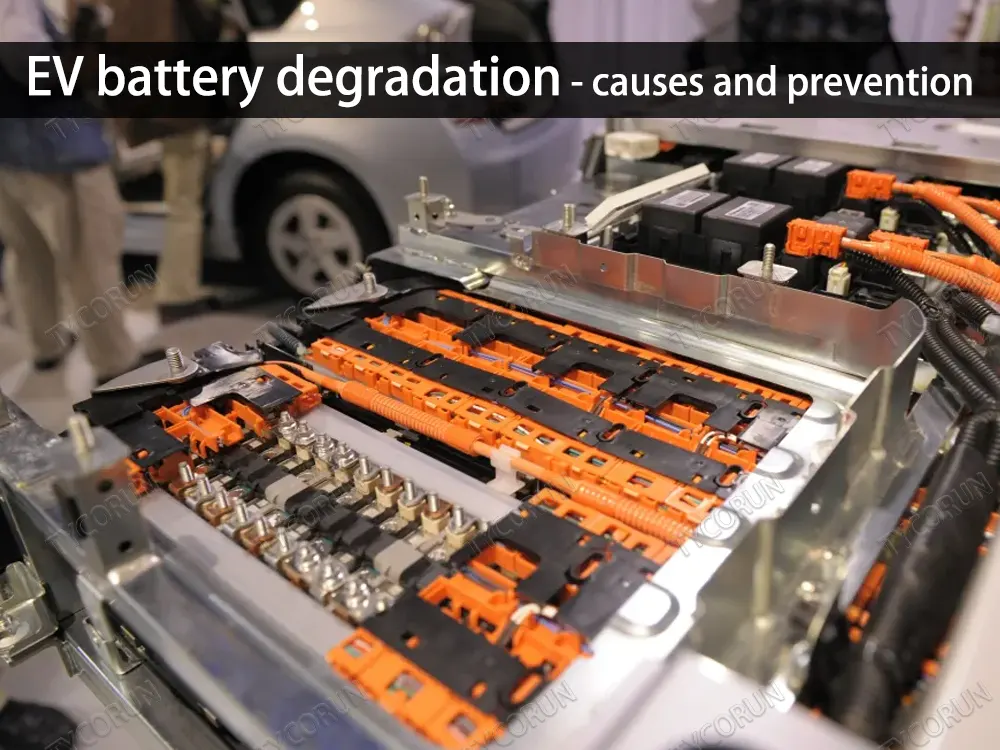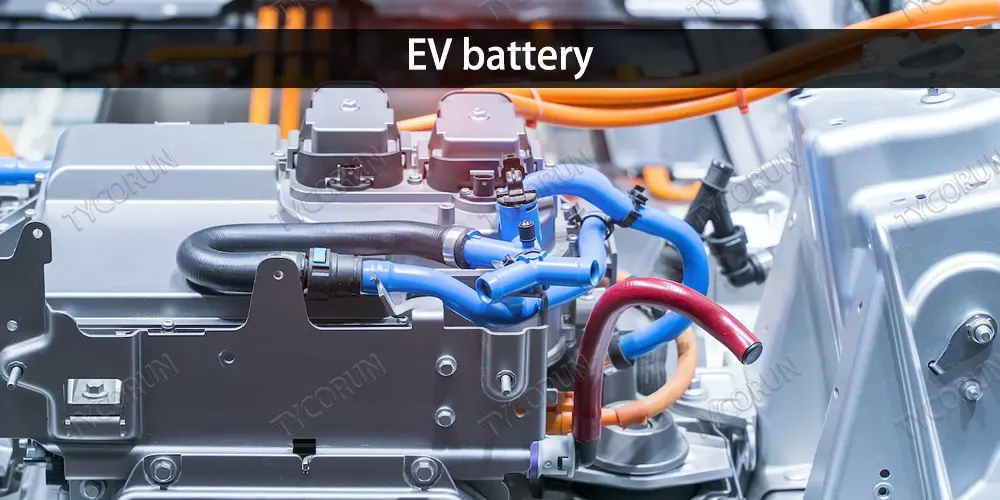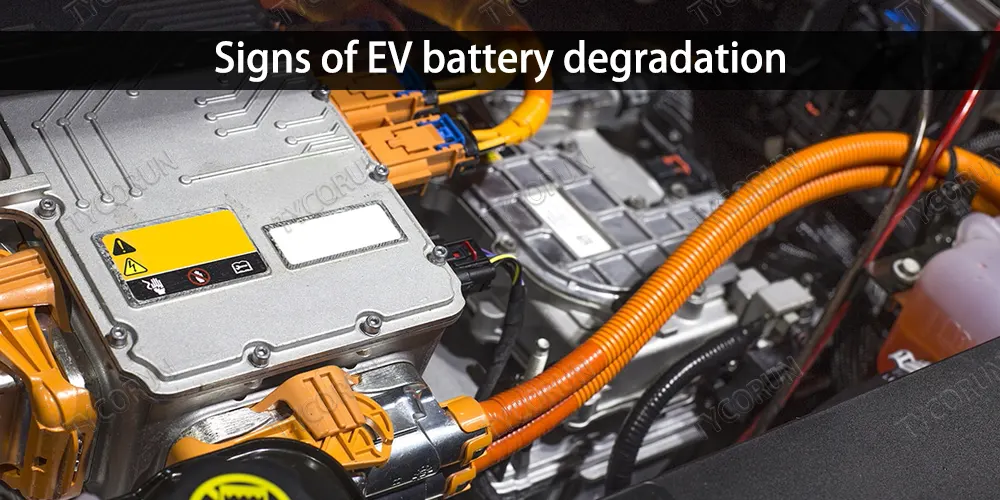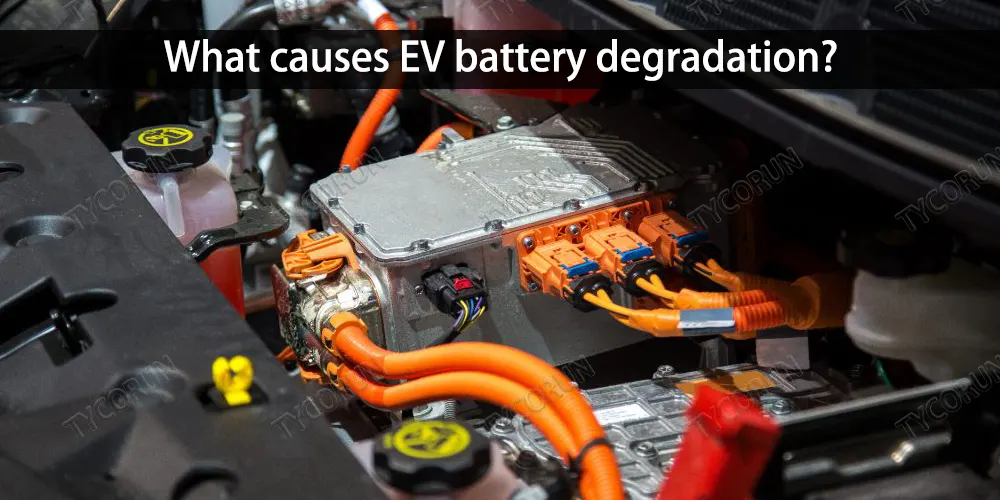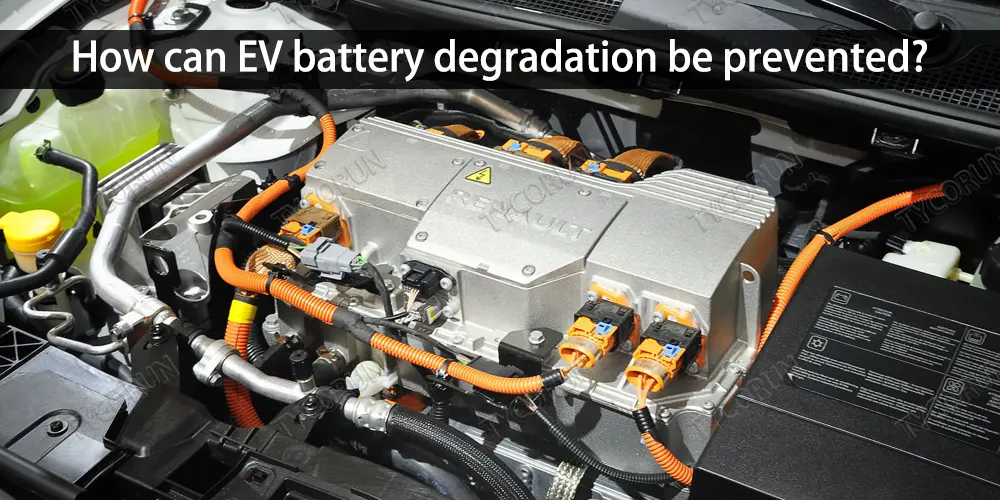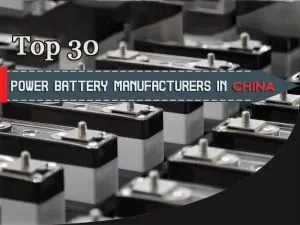Home » electric car battery » EV battery degradation – causes and prevention
EV battery degradation - causes and prevention
EV battery degradation impacts the battery’s capacity to store energy and its overall health and lifespan. In this article, you will learn about what EV battery degradation is, its signs, how to calculate it, the factors influencing it, and much more.
What is EV battery degradation?
Battery degradation is a phenomenon in which electric vehicle (EV) batteries gradually lose their capacity to store energy over time. This leads to reduced overall efficiency, energy capacity, power output, and driving range.

Predicting EV battery degradation is challenging because batteries from various manufacturers have different potential and standards. Other factors that influence degradation include usage frequency, total mileage, maintenance practices, and environmental conditions.
If your battery is routinely depleted to near-zero range and then charged to full capacity, or if your battery is consistently subjected to Level 3 fast charging, it can accelerate battery degradation. This is why automakers recommend limiting Level 3 fast charging.
To maximize benefits and achieve better performance, it is advisable to charge EVs between 60 and 80 percent capacity. Additionally, it’s important to avoid fast charging and prolonged exposure to extreme temperatures.
Which EV battery lasts longer in terms of battery degradation?
There are various types of EV batteries, including lithium batteries, lithium-sulfur batteries, nickel metal hydride batteries, hydrogen fuel cells, etc. and more. As a result of different chemistries and manufacturing standards, EV battery degradation also varies.
Lithium-ion batteries are the most commonly used type in electric vehicles today. At the same time, they can lasts longer than other types of battery. However, even within the lithium-ion battery category, performance degradation can vary between manufacturers.
Generally speaking, lithium iron phosphate battery tend to have a longer service life than ternary lithium battery. Of course, the exact lifespan of an EV battery may depend on a variety of factors, such as manufacturer, usage patterns and charging habits.
What are the signs of EV battery degradation?
As mentioned earlier, EV battery degradation is a phenomenon that takes place gradually over time. It may not be immediately noticeable when it begins, but there are common signs and indications that can help you identify battery degradation.
If you observe any of these signs in your battery, it’s advisable to take precautionary measures.
● Reduced Performance: You’ll notice a change in acceleration and an overall drop in vehicle performance as your battery begins to degrade.
● Reduced Range: One of the most noticeable signs of battery degradation is a decrease in your vehicle’s driving range. It won’t cover the same distance on a single charge as it used to.
● Longer Charging Times: Slower charging is a clear indicator of battery degradation. Degraded batteries take more time to charge, especially at higher charging levels, compared to newer batteries.
● Increased Charging Frequency: Your vehicle will require more frequent charging as the battery’s energy storage capacity diminishes.
● Increased Energy Consumption: If your vehicle starts consuming more energy over time to cover the same distance, it’s a sign that your battery is degrading.
● Unpredictable Charging Behavior: When your battery exhibits unpredictable charging behavior, such as shutting down unexpectedly or failing to reach a full charge even after an extended charging period, it’s another indication of degradation.
How quickly does EV battery degradation occur
Battery degradation is a gradual process that doesn’t happen immediately. It results in the vehicle losing range gradually and requiring more frequent charging.
On average, EV batteries lose about one percent of their range each year. Some batteries, like those in the Tesla Model S, are designed for durability and can outlast the vehicle’s usable life.
Battery degradation occurs over time, regardless of whether you drive your vehicle frequently or not.
What causes EV battery degradation?
EV battery degradation is influenced by various factors, including time, charging cycles, temperature, and more. Below, you will find a detailed exploration of these factors to help you better care for your product.
● Charging Frequency: Frequent use of fast charging can reduce battery capacity and overall performance due to increased heat generation. While modern batteries are designed to handle fast charging, excessive use is detrimental to battery health.
● Cycling: The number of charge and discharge cycles directly impacts degradation. Frequent charging and aggressive driving can accelerate this process.
● Temperature: Extreme temperatures have a direct correlation with battery degradation. Cold temperatures reduce performance, while hot temperatures can break down the battery’s electrolyte, leading to reduced charge-holding capacity.
● Depth of Discharge (DOD): Battery degradation is exacerbated when the battery is charged to its highest levels from near-empty levels.
Other factors like manufacturing variations, age and mileage, environmental factors, and quality of the battery management system also play a role in battery degradation.
How do you calculate EV battery degradation?
If you’re concerned about calculating EV battery degradation, rest assured; it involves straightforward steps.
Typically, degradation can be assessed through the battery’s State of Health (SoH), which is determined by comparing its current capacity to its original capacity.
Here’s a simple guide:
1. Measure Initial Capacity: Record the battery’s capacity when it’s brand new and fully charged. This provides a reference point for future comparisons.
2. Regular Capacity Checks: As the battery is used, its capacity gradually decreases. Some vehicles feature built-in vehicle management software, while others require diagnostic tools to monitor capacity at specific intervals.
3. Compare Capacities: Compare the battery’s original capacity with its current capacity to gauge degradation.
4. Data Analysis: Examine the recorded data, including capacity and other factors like temperature, usage patterns, and charging habits, to assess the battery’s current health.
5. Life Expectancy Prediction: Utilize the analyzed data, along with the manufacturer’s guidelines and specifications, to estimate the battery’s expected lifespan.
How can EV battery degradation be prevented?
EV battery degradation is an inevitable process, but you can slow it down to extend its lifespan. According to surveys, EV batteries can last up to 500,000 miles, but neglect can reduce their longevity.
To prevent or mitigate degradation, follow these simple practices:
1. Maintain Adequate Charge: Avoid driving with a battery charge below 20%. Always ensure your vehicle is well-charged before leaving and has sufficient charge when returning home.
2. Optimal Charging: Don’t overcharge your vehicle; keep it between 60-80%. Avoid exceeding 80% charge.
3. Manage Temperature: Extreme temperatures, whether hot or cold, can adversely affect the battery and accelerate degradation. Store your vehicle in moderate temperatures whenever possible.
4. Limit DC Level 3 Fast Charging: Frequent use of DC Level 3 fast charging is detrimental to your vehicle’s battery health, so use it sparingly.
How does EV battery degradation affect recycle value?
Degraded batteries can still find a second life in the market after recycling, but degradation can indeed impact their recycling value.
The following points outline the factors influencing this effect:
Reduced Capacity: Battery degradation initially diminishes the battery’s energy storage capacity, consequently reducing its value in the secondary market, where it’s often used for stationary energy storage.
Challenging Chemical Recovery: Severely degraded batteries may become unsuitable for recycling due to irreversible changes, making it difficult to recover valuable materials like lithium, cobalt, and nickel.
Recycling Costs: Recycling highly degraded batteries can be prohibitively expensive, whereas battery recycling processes are typically cost-effective and efficient.
Market Demand: The demand for recycled materials fluctuates in the market. High demand for recycled materials can sometimes offset the value loss due to degradation.
Conclusion
EV battery degradation, while not overly complex, is a nuanced phenomenon influenced by various factors.
By identifying its signs and taking precautionary steps, one can’t completely prevent battery degradation but one can certainly slow it down. Manufacturers are actively enhancing battery lifespan through new battery solution.
However, you can also contribute by practicing responsible battery care, such as avoiding overcharging, fast charging, exposure to extreme temperatures, and adopting other measures to mitigate the degradation process.
FAQs
EV battery degradation cannot be reversed as it's an irreversible process. Over time, both the capacity and performance of the battery naturally decline. However, with proper maintenance and charging practices, this process can be slowed down.
Cold temperatures can reduce battery efficiency and overall range, leading to EV battery degradation during winter. Some manufacturers have introduced designs to mitigate temperature effects on batteries, but proper care remains essential.
You can monitor your EV battery's health by observing degradation signs, checking its state of charge, and tracking vehicle range. Additionally, many batteries come equipped with built-in tools that offer detailed insights into battery health.


